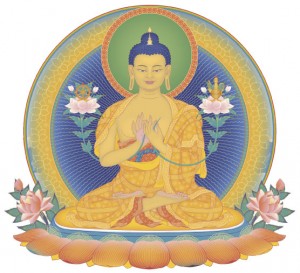A Buddha is a being who has awakened from
the dreamlike delusions that evolving beings mistakenly grasp as objective reality.
In Mahayana Buddhism all sentient beings, human and animal, are regarded as having
Buddha seed and are ultimately capable of awakening.
Spiritual path
'....The teachings of Buddha reveal a step by step path to lasting happiness. By
following this path anyone can gradually transform his or her mind from its present
confused and self-centered state into the blissful mind of a Buddha. ....As Geshe Kelsang
says in his popular book Eight Steps to Happiness:
Every living being has the potential to become a Buddha,
someone who has completely purified his or her mind of all faults and limitations and has
brought all good qualities to perfection. Our mind is like a cloudy sky, in essence clear
and pure but overcast by the clouds of delusions...'
The very
subtle mind
'...The mind is neither physical, nor a by-product of purely physical processes,
but a formless continuum that is a separate entity from the body. When the body
disintegrates at death, the mind does not cease. Although our superficial conscious mind
ceases, it does so by dissolving into a deeper level of consciousness, called 'the very
subtle mind'. The continuum of our very subtle mind has no beginning and no end....'
Hinayana and
Mahayana
'....After he had attained enlightenment, as a result of requests Buddha rose from
meditation and taught the so-called first "Wheel of Dharma. These teachings, which
include the Sutra of the Four Noble Truths and other discourses, are the principal source
of the Hinayana, or Lesser Vehicle, of Buddhism. Later, Buddha taught the second and third
Wheels of Dharma, which include the Perfection of Wisdom Sutras and the Sutra
Discriminating the Intention, respectively. These teachings are the source of the
Mahayana, or Great Vehicle, of Buddhism. In the Hinayana teachings, Buddha explains how to
attain liberation from suffering for oneself alone. In the Mahayana teachings he explains
how to attain full enlightenment, or Buddhahood, for the sake of others. Both traditions
flourished in Asia, at first in India and then gradually in other surrounding countries,
including Tibet. Now they are also beginning to flourish in the West...'
More about Buddha
Arguments against Buddhism
To understand the strengths of a philosophy one should attempt to refute it.
- Sean Robsville
RATIONAL
BUDDHISM
If we regard Buddhism as a combination of a philosophy, psychology and religion, then how
much mileage can we get from the first two aspects before we have to start invoking
religious faith?
Christian
versus Buddhist worldviews |
